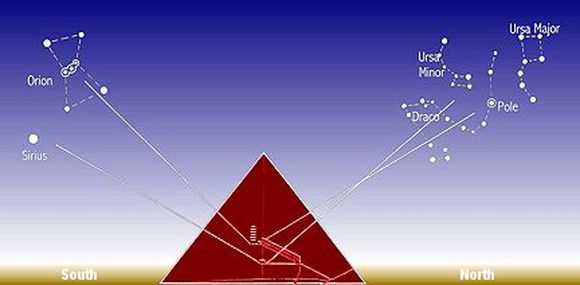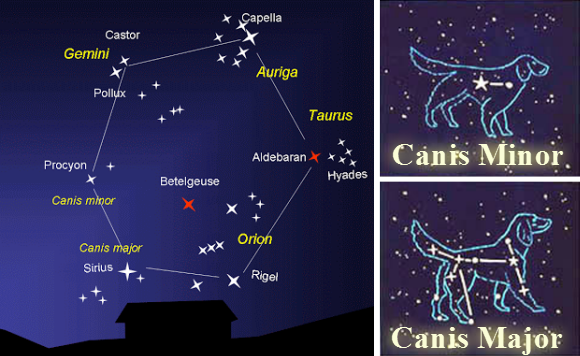Given a clear and dark sky, February is a great time to become acquainted with the winter celestial dome. The southern aspect is especially studded with stellar jewels.
 Of these no star catches the eye more than Sirius, brightest in the entire night sky. Also known as the ‘Dog star’, Sirius lies in Canis Major - the Great Dog, a constellation that from the UK just clears the horizon. Because Sirius is both brilliant and appears relatively low, the effects of scintillation (twinkling) are very pronounced.
Of these no star catches the eye more than Sirius, brightest in the entire night sky. Also known as the ‘Dog star’, Sirius lies in Canis Major - the Great Dog, a constellation that from the UK just clears the horizon. Because Sirius is both brilliant and appears relatively low, the effects of scintillation (twinkling) are very pronounced.
This twinkling is not of course due to the star itself, but is caused by our atmosphere, which perturbs the light path as it passes through the ‘thin blue layer’ surrounding our planet. Indeed, it is not uncommon for Sirius to be the source of mistaken UFO sightings by the ‘night sky unwary’. When viewed through binoculars or a telescope,
Sirius is a mesmerizing spectacle of ever-changing sparkling hues. Throughout human history Sirius, meaning, “sparkling or scorching one” has been the most brilliant of the fixed stars and as such revered in many cultures.
In ancient Egypt around 3000 BC, Sirius was the “Nile star” whose appearance just before dawn near the summer solstice heralded the impending rise of the Nile into flood, an event upon which Egyptian agriculture and therefore civilization depended. This “helical” or first rising is referred to in numerous temple inscriptions such as those at Karnak and Denderah, which were orientated to the rising of Sirius.

Sirius: Portal to the Afterlife. Image Credit: Robert Bauval
In Egyptian culture Sirius also represented the portal to the afterlife and when hidden from view by the sun’s glare; as it was for a 70 day period, the Egyptians did not bury the dead, believing the portal was closed. In the ancient Greek and Roman world, the rising of Sirius was regarded as unfortunate, its searing light thought to add to the scorching heat of July and August and attributed to bringing forth fever and madness during the so called “dog days of summer”.
Sirius itself is double the size and twenty six times more luminous than our Sun. However, the chief reason for its eminence in our night sky is due to its proximity, a mere 8.5 light years away, making it the 5th nearest star. It is believed to be a member of the Ursa Major stream, a moving cluster of stars that also contains five of the Plough’s stars.
Sirius is actually a binary star, travelling through space with a companion dubbed the ‘Pup’. This is the degenerate core of a star that once might have resembled our Sun. Such stars are called White Dwarfs and are extremely small, but have incredibly high densities; the Pup for instance is estimated to be just 20,000 miles across, but a thimble full would weigh several hundred tons. Although technically visible in a modest scope, the overwhelming glare of Sirius itself renders the pup undetectable unless a special filter device is used. Still, it remains the most famous member of this strange class of stars.

Winter Hexagon, including Canis Major (bottom left) and CanisMinor (above it).
Image Credits: SLW and Richard Bosman.
The Greater Dog is accompanied across the sky by the lesser dog - Canis Minor, which lies at shoulder height to Orion and some way above Sirius. Its chief star Procyon – meaning “before the dog”, is the 8th brightest star in the sky. It is also situated nearby at just over 11 light years. Like Sirius, Procyon is accompanied by a white dwarf star.
Several legends are attached to these groups. One Greek myth associates Canis Major with Laelaps, who in a race outran the fastest creature in the world (supposedly a fox) for this reason Zeus placed him in the sky.
Another myth has both the dogs assisting Orion whilst he was out hunting. The greater dog is pursuing Lepus- the Hare, visible in the sky crouching below the feet of Orion. The lesser dog is stranded on the other side of a river, the Milky Way. Careful observation of this region of the sky from a dark location does reveal the winter Milky Way flowing between the constellations.
Yet another tale has the two dogs sitting under the table at which the twins of Gemini (Castor and Pollux) are dining. The faint stars between Canis Major and Gemini are the crumbs the twins have been feeding to the animals.
If skies are clear, do then check out the two dogs, in particular the ‘dog star’– but don’t go barking mad!
- Log in to post comments
